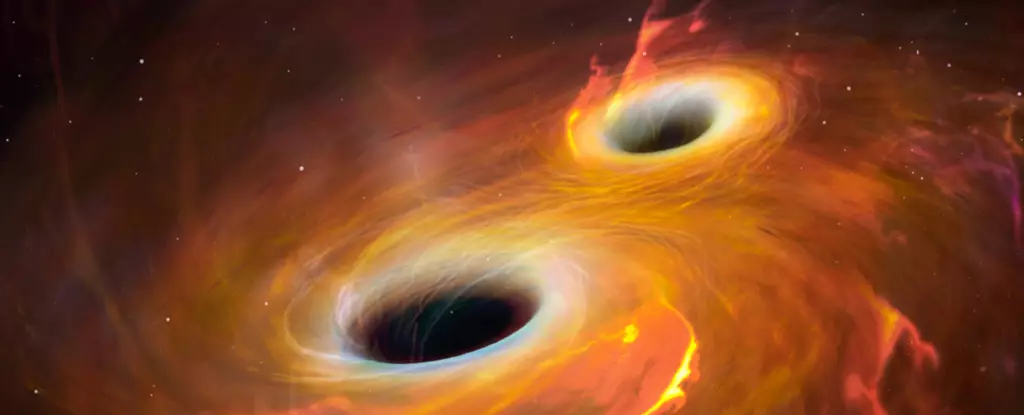At the heart of our galaxy lies a gravitational enigma: a supermassive black hole known as Sagittarius A* (Sgr A*), surrounded by a vibrant tapestry of young stars, gas, dust, and an elusive population of stellar-mass black holes. This central hub is a dynamic cosmological stage where creation and destruction coalesce amid the shrouding veil of interstellar matter, preventing clear observations in the visible spectrum. Instead, astronomers are turned to infrared and radio wavelengths to peer through the cosmic fog, capturing glimpses of stars while the stellar-mass black holes remain enshrouded in mystery. The complexity of this region evokes a wealth of questions: How many black holes lie in wait? What processes underpin their formation?
The Traditional Paradigm: A Sparse Galaxy Center
For decades, scientists have relied on traditional models of star formation to theorize the numbers of these enigmatic entities. The prevailing view suggested a modest estimate of approximately 300 stellar-mass black holes residing close to Sgr A*. This conservative calculation is built on established understandings of stellar evolution and the processes that lead to black hole formation. However, newer insights challenge this notion significantly, compelling astronomers to rethink their models and consider a much more threaded narrative of galactic evolution.
The Star Grinder: A Game-Changing Hypothesis
A recent study published in *Astronomy & Astrophysics* proposes an audacious idea: the so-called “star grinder” model, which paints a much richer picture of the central region. In this hypothesis, the concentration of gas and dust near Sgr A* creates an environment conducive to the rapid formation of massive O-type and B-type stars. These stars, known for their short lifespans, would inevitably culminate in supernova explosions, leading to the formation of black holes. As massive stars die, they not only contribute to the black hole population but also regenerate material to fuel the formation of new stars.
This cyclical mechanism suggests that the region is in a constant state of turmoil and regeneration, with the potential to cram millions or even billions of stellar-mass black holes into a cubic parsec. Imagine entering this turbulent zone—a cosmic arena—where each collision of stars and black holes dramatically influences the fate of celestial bodies. The implications are staggering: if accurate, this model transforms our understanding of the galactic core from a mere void interspersed with a few black holes to a bustling center of cosmic activity.
Collision Time: The Statistical Framework
To substantiate their claims, the authors employ a statistical tool known as collision time, the average duration before a star collides with a black hole based on their respective densities. This concept elegantly intertwines with observational data, particularly concerning the largest and most detectable O-type stars. The authors deduce that the relative scarcity of these grand stars near Sgr A* suggests they are undergoing what can be termed as black hole “grinding.”
The larger the population of black holes, the shorter the average collision time, inherently increasing the likelihood that massive stars would encounter these gravitational predators. As it stands, the preliminary conclusions of the study argue that a staggering estimate of 100 million black holes per cubic parsec could populate the vicinity of Sgr A*. Such a claim would rewrite the cosmic narrative of our galaxy’s center, where environments once believed sparse are instead brimming with dark activity.
Hypervelocity Stars: Evidence of Cosmic Collisions
Compounding the excitement surrounding this new model is its ability to explain the phenomenon of hypervelocity stars—celestial bodies that have attained such speeds they are on trajectories to escape the Milky Way. Traditionally, these stars have been a source of intrigue, with little consensus on their provenance. However, the mechanistic nature of the star grinder model suggests that close encounters with black holes at the galaxy’s core could facilitate these remarkable velocities. As notable as this correlation may seem, it accentuates the idea that the supermassive presence of black holes actively shapes stellar fates in the galactic center.
The Future of Black Hole Insights
Admittedly, while the hypothesis is a tantalizing new perspective on the dynamics near Sgr A*, the interpretive challenges remain palpable. Empirical observation and validation of these claims will require advanced instrumentation and novel methodologies to unravel the deep interstellar complexities that elude our current understanding. Yet if proven, the revelations about black hole density and behavior in the galactic core could ignite a renaissance in astrophysical inquiry—a re-evaluation of not just our galaxy, but cosmic structure on a grand scale, guiding future research endeavors into the labyrinth of dark matter and its predominance in shaping the universe’s grand designs.


Leave a Reply